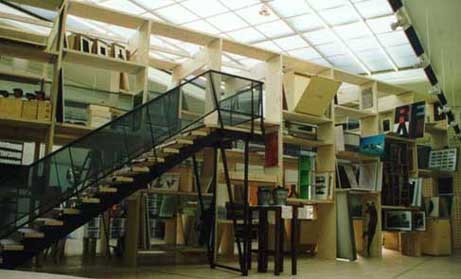"Kunst ohne Unikat (Art [form] without a unique work)"
Neue Galerie Graz, Graz, Austria
27. 09. 1998 - 26. 10. 1998

Exhibition view, Kunst ohne Unikat at Neue Galerie Graz, 1998. Photo: K. Tattermus.
Artists: Robert Adrian X., Iris Andrascheck, Ian Anüll, John M. Armleder, Christian Ludwig Attersee, Christian Bachler, John Baldessari, Mohammed el Baz, Heiner Blum, Cosima von Bonin, Ecke Bonk, Gilbert Bretterbauer, Max Bühlmann, Marie-Jose Burki, Ernst Caramelle, Georgia Creimer, Franz Josef Czernin, Josef Danner, Jiri David, Plamen Dejanov, Johannes Deutsch, Horst Maria Doppler, Bronislava Anatolevna Dubner, Feng Mengbo, Günther Förg, G.R.A.M., Jakob Gasteiger, Kendell Geers, Marcus Geiger, Walter Grond, Thomas Grünfeld, Roman Haubenstock – Ramati, Swetlana Heger, Thilo Heinzmann, Richard Hoeck, Leiko Ikemura, Hans Jandl, Georg Jirak, Ronald Jones, Franco Kappl, Michael Kienzer, Martin Kippenberger, Udo Koch, Peter Kogler, Joseph Kosuth, Brigitte Kowanz, Andreas Kunzmann, Hans Kupelwieser, Louise Lawler, Sol Le Witt, Hans-Jörg Mayer, John Miller, Hoshyar Mohiden, Christian Philipp Müller, Tadeusz Myslowski, Maurizio Nannucci, Stefan Nessmann, Lucia Nogueira, Albert Oehlen, Franz Pomassl, Manfred Wolff-Plottegg, Tobias Rehberger, Werner Reiterer, Bernhard Riff, Rivka Rinn, Gerwald Rockenschaub, Chéri Samba, Eva Schlegel, Jörg Schlick, Hubert Schmalix, Ferdinand Schamtz, Michael Schuster, Hartmut Skerbisch, Gunther Skreiner, Werner Stadler, Haim Steinbach, Christoph Steinbrener, Thomas Stimm, Christian Stock, Wolfgang Stückler, Gustav Troger, Mitja Tusek, Hartmut Urban, Matta Wagnest, Martin Walde, Franz Wanner, Peter Weibel, Hans Weigand, Franz West, Fred Wilson, Günther Wizemann, Erwin Wurm, Joseph Zehrer, Michael Zinganel, Heimo Zobernig
In the shadow of classical art, a democratic and thus popular art form has developed, the so-called edition art. In this art form, which goes back to historical techniques of pictorial media from the 15th to the 19th century (woodcut, copperplate engraving, etching, aquatint, lithography, etc.), there have been exciting and decisive developments in the 20th century, especially since the 1960s. The development went from serigraphy to the photomechanical offset printing process to three-dimensional objects. In the process, the multiple, the ars multiplicata, the duplicated art is mistakenly understood as a confrontation between original and copy or original and reproduction. One confuses the terms original and unique. The claim to singularity also loses validity with the subject of the artist himself. The artist does not create the work as an individual, but as a rule together with others, e.g. a technician, craftsman or the viewer. Through this emancipation of collective and conceptually multi-layered processes of generation, the multiple initiated and brought about fundamental changes in the art of the 20th century.
The symposium of the same name that introduces the exhibition, with leading experts, attempts first to clarify the conceptual dispute and second to show that since Marcel Duchamp (1913), edition art has gone far beyond the field of printmaking.
Just as electro-acoustic music was the model for the avant-garde in the 1950s, so digital audio technology is the model for emancipatory practices in art today. The symposium "Art without Uniqueness/ Multiple and Sampling as a Medium", aims to adequately address one of the most significant developments in art and music of the 20th century.
Symposium
Kunst ohne Unikat
Multiple and Sampling as a Medium: Techno-Transformations of Art
25. Sep. 1998, 2 to 10 p.m.
Priesterseminar (former Jesuitenkollegium), Bürgergasse 2, 8010 Graz
Source:
Neue Galerie Graz
Joanneumsviertel, 8010 Graz
Austria
tel. +43-316-8017-9100
joanneumsviertel@museum-joanneum.at
https://www.museum-joanneum.at/en/neue-galerie-graz